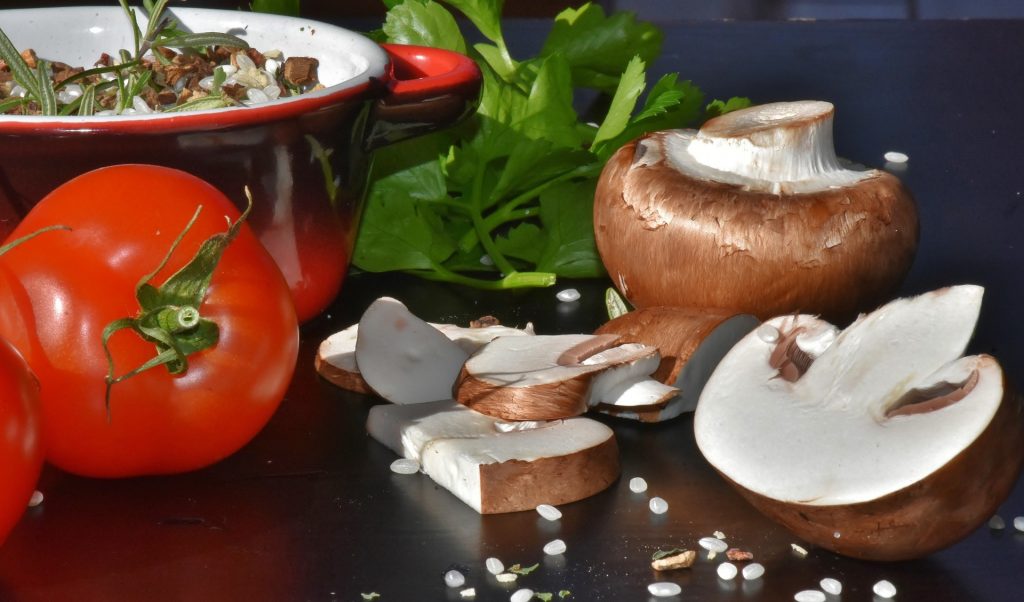 Vitamin D is a steroid hormone required by humans for correct bone, immune and calcium regulation. Humans can synthesise vitamin D when their skin is exposed to ultraviolet light, or can get vitamin D from food. Vitamin D is not a single compound but a group of compounds that exert similar biological activities. Cholecalciferol is the animal form of vitamin D, also called vitamin D3 and can be found in food such as liver, eggs, fish liver oils, butter, cheese and milk. Ergocalciferol is the ‘plant’ form of vitamin D and is also called vitamin D2. Mushrooms can be a good source of vitamin D2 and they can synthesise ergosterol when exposed to ultraviolet light, in a similar way that humans synthesise cholecalciferol. However, most foods contain only low amounts of vitamin D and so supplements are recommended during times of low sun exposure. Both ergocalciferol and cholecalciferol are able to be used by humans, although humans and other animals only synthesise cholecalciferol endogenously.
Vitamin D is a steroid hormone required by humans for correct bone, immune and calcium regulation. Humans can synthesise vitamin D when their skin is exposed to ultraviolet light, or can get vitamin D from food. Vitamin D is not a single compound but a group of compounds that exert similar biological activities. Cholecalciferol is the animal form of vitamin D, also called vitamin D3 and can be found in food such as liver, eggs, fish liver oils, butter, cheese and milk. Ergocalciferol is the ‘plant’ form of vitamin D and is also called vitamin D2. Mushrooms can be a good source of vitamin D2 and they can synthesise ergosterol when exposed to ultraviolet light, in a similar way that humans synthesise cholecalciferol. However, most foods contain only low amounts of vitamin D and so supplements are recommended during times of low sun exposure. Both ergocalciferol and cholecalciferol are able to be used by humans, although humans and other animals only synthesise cholecalciferol endogenously.

Mushrooms can synthesise ergocalciferol in their tissues through the action of ultraviolet light. Button mushrooms are a particularly rich in ergocalciferol. However, studies show that mushrooms can synthesised approximately 4 times more ergocalciferol when their gills are exposed to ultraviolet A light, compared to their caps (22.8 μg/g dry mass versus 5.16 μg/g dry mass). Exposure of the stalk produces much less ergocalciferol (2.97 μg/g dry mass). When the gills of button mushrooms are exposed to ultraviolet A light, the rate of synthesis of ergocalciferol is not as high as for enoki, abalone, shiitake or oyster mushrooms (12.5 versus 18.8, 22.6, 22.8 and 45.1 μg/g dry mass, respectively). Optimum moisture content for vitamin D conversions has been calculated at 78 % with a temperature of around 35℃.
Because of the difficulty in acquiring enough vitamin D from foods, researchers are interested in novel ways to provide food sources of vitamin D. Cod liver oil is the traditional food used as a food source of vitamin D because fish liver oils are one of the best sources. Mushrooms may be a good source of vitamin D, as the vitamin D content of mushrooms can be increased significantly by exposing the mushrooms to ultraviolet light. A number of studies have investigated the ergocalciferol content of mushrooms and found that the ergocalciferol content of the mushrooms is not uniform. One study for example showed that those areas most exposed to ultraviolet light had significantly higher concentrations of ergocalciferol compared to those areas less exposed. The study also showed that button mushrooms contained higher concentrations of vitamin D (7.80 mg/g dry mass) than shiitake (6.06 mg/g dry mass), oyster (4.40 mg/g dry mass), abalone (4.35 mg/g dry mass) and enoki (0.68 mg/g dry mass) mushroom.
Eat Well, Stay Healthy, Protect Yourself
RdB
